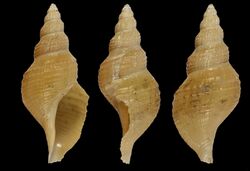Biology:Phymorhynchus castaneus
| Phymorhynchus castaneus | |
|---|---|

| |
| shell of Phymorhynchus castaneus (holotype at the Smithsonian Institution) | |
| Scientific classification | |
| Domain: | Eukaryota |
| Kingdom: | Animalia |
| Phylum: | Mollusca |
| Class: | Gastropoda |
| Subclass: | Caenogastropoda |
| Order: | Neogastropoda |
| Superfamily: | Conoidea |
| Family: | Raphitomidae |
| Genus: | Phymorhynchus |
| Species: | P. castaneus
|
| Binomial name | |
| Phymorhynchus castaneus (Dall, 1896)
| |
| Synonyms[1] | |
|
Pleurotomella castanea Dall, 1896 | |
Phymorhynchus castaneus is a species of sea snail, a marine gastropod mollusk in the family Raphitomidae.[1]
Phymorhynchus castaneus is the type species of the genus Phymorhynchus.[2]
Distribution
This species occurs in the Pacific Ocean off the Galapagos Islands[2] (collected from the depths of 1,322 fathoms (2,418 m))[2] and in the Gulf of Panama (in the depth 1,823 fathoms (3,334 m)).[2]
Description
The shell is polished, thin. It is resembling Phymorhynchus cingulatus (Dall, 1890), of a chestnut-brown color, fading to a paler pinkish-brown, with seven whorls. The nucleus eroded, the early whorls are with four or five flattened elevated spirals with wider interspaces in front of a somewhat sloping anal fasciole, more or less reticulated by narrow, slender, irregular, elevated riblets in harmony with the lines of growth, and which form on the fasciole delicate arches concave forward. The suture is appressed. On the body there are about twenty spirals, stronger at the shoulder, smaller and closer forward, the wide interspaces finely spirally striate, while the most prominent spirals are undulate or obscurely nodulous. The transverse sculpture is nearly obsolete and hardly to be distinguished from the incremental lines. The aperture is elongate and oval. The outer lip is thin, sharp, crenulated by the sculpture, but not lirate. Anal sulcus is shallow, wide, directly in front of the suture. Body whorl is with a thin wash of callus. Pillar is thin, gyrate, attenuated in front, forming a narrowly pervious axis, the whole of a pinkish-brown color. The canal is short, shallow, not recurved.[2]
The width of the shell is 23 millimetres (0.91 in) and the height is 53 mm (2.1 in). The height of the last whorl is 38 mm (1.5 in), and the height of the aperture is 28 mm (1.1 in).[2]
Phymorhynchus castaneus differs from Phymorhynchus cingulatus by its smaller size, more sloping whorls, more delicate and reticulate sculpture, and by its pervious axis.[2] The animal is blind, and there is no operculum.[2]
References
This article incorporates public domain text from the 1908 reference "Reports on the Dredging Operations off the West Coast of Central America...".[2]
- ↑ 1.0 1.1 Phymorhynchus castaneus (Dall, 1896). Retrieved through: World Register of Marine Species on 18 January 2011.
- ↑ 2.0 2.1 2.2 2.3 2.4 2.5 2.6 2.7 2.8 Dall W. H. (1908). "Reports on the Dredging Operations off the West Coast of Central America to the Galapagos to the West Coast of Mexico, and in the Gulf of California, in charge of Alexander Agassiz, carried on by the U. S. Fish Commission Steamer "Albatross", during 1891, Lieut. Commander Z. R. Tanner, U. S. N., Commanding, XXXVII and Reports on the Scientific Results of the Expedition to the Eastern Tropical Pacific, in charge of Alexander Agassiz, by the U. S. Fish Commission Steamer "Albatross," from October, 1904, to March, 1905, Lieut. Commander L. M. Garrett, U. S. N., Commanding. XIV. The Mollusca and the Brachiopoda". Bulletin of the Museum of Comparative Zoology at Harvard College 43(6): 205-487 + plates. page 258, page 284.
External links
- Tucker, J.K. (2004). "Catalog of recent and fossil turrids (Mollusca: Gastropoda)" (PDF). Zootaxa 682: 1–1295. http://www.mapress.com/zootaxa/2004f/z00682f.pdf.
- Gastropods.com: Phymorhynchus castaneus
Wikidata ☰ Q7189468 entry
 |

